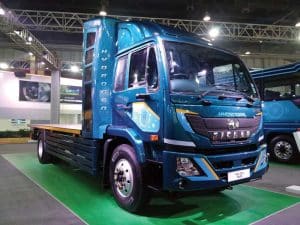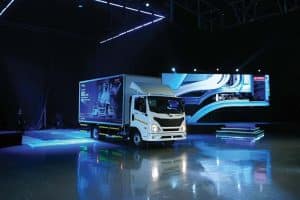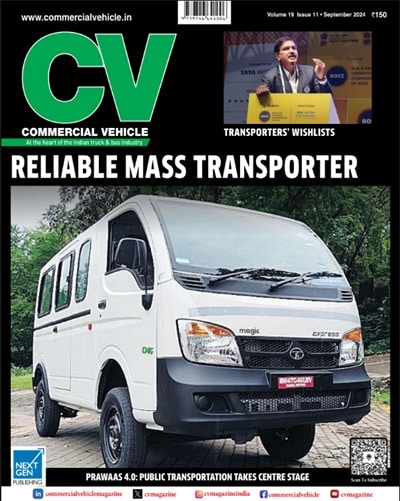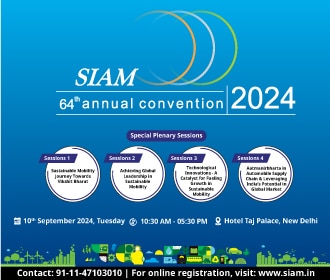In an Industry Talk session, Vinod Aggarwal, President, SIAM and Managing Director and Chief Executive Officer at VE Commercial Vehicles Ltd. spoke to Ashish Bhatia on most indicators being in green barring the developed economies posing a challenge.
 Q. How were the FY23 sales and production volumes for VECV and from a Total Industry Volume (TIV) standpoint?
Q. How were the FY23 sales and production volumes for VECV and from a Total Industry Volume (TIV) standpoint?
A. The fiscal year FY23 proved to be a fruitful one for the entire CV industry, including VECV. We broke all our earlier records by surpassing our earlier peak levels of 2018-19. In FY23, we sold 79,623 vehicles as compared to 57,077 units last year in FY22, marking a growth of 39.5 per cent which beat industry growth. This has been possible on the back of our continuous focus on uptime for our customer.
Talking about the industry, the TIV for FY23 stood at 4,74,177 units marking a growth of 38.1 per cent as compared to FY22. The growth was due to the improvement in freight movement across the country and the healthy infrastructure spend by the government. While the growth figure looks positive, it is still away from the peak of 2018-19 when the TIV stood at 557,517 units indicating a huge room for additional growth in coming years. With all the positives in place, we hope to see the CV industry reach its peak level of 2018-19 very soon.
Q. Which segment outperformed and is likely to take the momentum into the next fiscal year?
A. The Heavy Duty (HD) truck industry has grown strongly by 50.5 per cent due to the government focus on infrastructure development as well as the overall economic growth. In addition to this, the Light and Medium Duty (LMD) segment has also witnessed a growth of 46.2 per cent due to the growing demand for intra-city and last-mile transportation. Similarly, demand for buses, most severely impacted by the pandemic, is now almost back to pre-Covid-19 levels with the re-opening of schools and inter-city travel taking off, registering a growth of 258.8 per cent in the segment this year.
At VECV, we have sold 79,623 vehicles in FY23 as compared to 57,077 units sold last year in FY22 marking a growth of 39.5 per cent. The growth has been robust and consistent during the year, and we have been able to increase our presence across segments. In LMD trucks, we have grown our volumes by 20.8 per cent to 37,318 units in FY23. In HD trucks segments, we have significantly increased our presence with the growth of 74 per cent and registered highest ever yearly volumes of 18,965 vehicles in FY23. In the bus segment, we grew by 301.7 per cent to 14,924 units in FY23, also the highest ever in a year.
“While the growth figure looks positive, it is still away from the peak of 2018-19 when the TIV stood at 557,517 units indicating a huge room for additional growth in coming years. With all the positives in place, we hope to see the CV industry reach its peak level of 2018-19 very soon.”
Q. Any key takeaways that are fodder for the next fiscal year from both domestic as well as exports business perspective?
A. Despite various macroeconomic and global challenges, the GDP growth forecast for India remains buoyant at around seven per cent. Hence the domestic automobile industry’s sales volume is also expected to grow as there is a very close link between the two. The growth momentum is expected to be supported by favourable demand sentiments and various government initiatives for rural and urban development.
The industry is further witnessing a migration to tractors and trailers in the HD segment because of the improvement in road infrastructure. As more migrations happen, more replacements will be required, which would lead to more demand. The second driver for growth this year will be construction trucks, and the industry will see more demand for the same as the government continues to focus on improving the infrastructure.
To keep up with the new advancements, the industry must keep investing in new technologies. The industry might see a lot of movement toward the LNG truck in the long-haul segment, and the use of CNG might also increase with the recent correction of prices, as far as migration to alternative fuels is concerned. Additionally, the work on hydrogen fuel is still in progress as the industry will take around three to four years to be ready with the technology. The industry will experience slow and steady movements toward newer technology.
With a pro-growth budget in place, the CV industry in the domestic markets is expected to experience sustained growth. We are confident and optimistic that the CV industry will soon reach its peak level of 2018–19 thanks to robust demand and economic expansion.
Q. Are the core economic indicators pointing in the right direction?
A. Commercial vehicle sales and industrial GDP have a well-established positive association. As a result, it serves as an indicator of the state of the economy. During the pandemic, the CV market in India hit multi- year lows however, a rebound in economic activity and the restoration of interstate travel by individuals has led to a significant increase in demand for commercial vehicles from a variety of industries, including FMCG, construction, mining, e-commerce and city and interstate travel.
The government has put in place policies to grow India’s GDP to USD five trillion with several initiatives like the creation of the National Infrastructure Pipeline of Projects, the encouragement of capital expenditure, implementation of various PLI schemes, completion of the National Monetisation Pipeline of Public Sector Assets, and the formulation of the National Logistics Policy. The government has also laid focus on clean mobility solutions and net zero objectives with the launch of the National Green Hydrogen Mission which has a total outlay of Rs.19,700 crore.
“While most of the indicators are in green, there will be some challenges owing to recession in the developed economies, high levels of inflation, and supply chain issues prevailing due to ongoing geopolitical issues.”
 Q. How does that translate into sales across the truck and bus sub-segments?
Q. How does that translate into sales across the truck and bus sub-segments?
A. The growth in the CV industry is directly proportional to the growth of the economy, which is set to grow in FY24. All the above activities will translate into sales, and the uptake in the infrastructure segment will increase the sales of the heavy-duty segment. While the growth in e-commerce will drive the sales of LMD vehicles, buses will gain with replacement demand from schools and offices and uptake in demand for intercity travel.
Q. From a green mobility perspective, and based on the showcase at Auto Expo 2023 most recently, what are the focus areas across I&LCVs and M&HCVs?
A. At VECV, we are committed to Government’s vision for a sustainable, efficient, and affordable logistics ecosystem through application-specific alternate fuels, and smart support solutions. Recently, we showcased a range of clean and energy-efficient vehicles at Auto Expo 2023, namely, India’s longest 13.5m electric Intercity Coach, Eicher Pro 2049 electric 4.9-tonne GVW truck, Eicher Pro 8055 LNG/CNG truck and Volvo FM LNG 420 4×2 Tractor. These vehicles are a mix of electric, CNG, and LNG fuel base, indicating a need for diverse solutions for each segment. When it comes to LMD, electric and CNG are viable options, while LNG makes more sense for HD vehicles. For buses, electricity will be the go-to option as of now for the intra city public transport.
Q. Any white spaces that you are looking to fill?
A. As India’s third largest manufacturer we constantly evaluate industry developments and we continue to develop state-of-the-art and economically superior solutions to our customers.
Q. Where do the gasification plans vis-a-vis the supply-demand energy matrix stand?
A. In terms of the supply-demand energy matrix in the Indian auto industry, the focus has been on reducing emissions and improving fuel efficiency through the adoption of electric and hybrid vehicles, as well as the use of alternative fuels such as CNG, LPG, and biodiesel. The Indian government has also set a target of achieving 100 per cent electric vehicle sales by 2030, which indicates the country’s shift towards a greener energy matrix in the automotive sector. However, there are some challenges related to infrastructure, raw material sourcing, etc. While the government is working to address all these issues, completely transitioning the industry will take some time.
In such a scenario, fuel such as CNG and LNG are viable options, especially CNG, which is affordable and greener in comparison to diesel. It has witnessed good traction in the industry. At VECV, we offer the widest range of CNG vehicles starting from 4.9-16-tonne. As far as LNG is concerned, it’s a highly fuel-efficient option for long-haul application. But the Indian transportation ecosystem is not entirely ready for it. There are a few challenges related to its storage. However, VECV always believes in staying ahead of the curve and recently at Auto Expo 2023, we showcased an Eicher Pro 8055 LNG truck specifically designed to meet needs for clean transport in long-haul applications. We also showcased Volvo LNG-powered FM 420 4×2 Tractor, which is under trials and expected to be launched in India when the conditions are suitable.
Q. How do the Pithampur plant and the new Bhopal plant with its capacity augmentation place you to meet the near to medium-term demand?
A. VECV has always spearheaded the future of Indian trucking with next-gen vehicles and innovative support solutions. The company has best-in-class manufacturing facilities with the latest technology to cater to dynamic market requirements and evolving customer needs. The Pithampur plant has a production capacity of over 90,000 vehicles per year. The plant is equipped with state-of-the-art manufacturing technologies and produces a range of commercial vehicles, including buses, trucks, and heavy-duty trucks. On the other hand, the new Bhopal plant, inaugurated in 2020, has an initial production capacity of 40,000 units per year. It is dedicated to producing our light and medium-duty trucks, which are in high demand in the Indian market. The total manufacturing capacity is scalable up to 1,40,000 vehicles which puts us in a strong position to grow our share of the commercial vehicle industry in India.
Q. With the RDE rollout effective April 01, how are you keeping operating margins under check? To what extent is the customer pass-through inevitable?
A. The BSVI OBD II implementation will have the larger benefit of a cleaner environment and better public health. It will be helpful in reducing on-road emissions for all vehicles since OBD II norms call for emission compliance in actual field operating conditions alongside test labs. OBD I to OBD II emission threshold is tightened ensuring a lower emission level in actual operation. Additionally, In-service conformity and In-use Performance Ratio monitoring ensure that vehicles are monitored for up to six years for emission compliance.
“Implementation of OBD II norms bridges the gap in the automotive emission level of India with developed nations and strengthens India’s global commitment to a cleaner environment.”
With this, there will be quite a few technological changes in the products, like the addition of physical and virtual sensors and their modeling. Additionally, robustness enhancement in components to meet desired emission compliance for six years will be required. This will require some price hike, however, it will be between three to five per cent as against 10 per cent during stage-I of BSVI.
Q. Is there an addition to the base engines and or platforms?
A. With the implementation of stage 2 of BSVI norms, a vehicle will have to on board a self-diagnostic system to continuously track its driving emission levels. This device will keep an eye on the emissions by scrutinising catalytic converter emissions and oxygen sensors. This will eliminate the need for laboratory tests and vehicles can be diagnosed in the field. The transition would also involve changes in the hardware and software of the vehicles, including an upgrade in semiconductors.
Q. What are the key drivers of a price hike for the industry as a whole?
A. While the commodity prices are low right now, they are higher than the average range. Various automotive companies have been absorbing a significant portion of the increased costs, but the steep rise in overall input costs has compelled them to pass on  some proportion through a minimal price hike. Another key driver is the implementation of stage-2 of BSVI norms; however, the hike is around three to five per cent depending on the model of the vehicle.
some proportion through a minimal price hike. Another key driver is the implementation of stage-2 of BSVI norms; however, the hike is around three to five per cent depending on the model of the vehicle.
Q. Tell us about export aspirations on the truck and bus side. Like the recent foray of the pro-2000 series in the Middle East?
A. With the idea of adding to the government’s vision of ‘Make in India’ for the World, VECV vehicles have now been exported to over 40 countries across the Middle East, Africa, South Asia, ASEAN and LATAM. We have recently strengthened our presence in West Africa, East Africa, South Africa and the Middle East by introducing the Eicher Pro 2000 series trucks. The company would take care of these market’s logistics and transportation needs and aspires to play a more significant role in the growth of these geographies. The Eicher Pro 2000 series is a modern range of trucks tailored to the unique customer needs in these regions. Eicher Trucks and Buses will be supplying this new product range through their increasing network of channel partners in the Middle East and African region. We also entered into Latin America last year and going forward we would like to expand our territory to Peru, Panama, Paraguay, Columbia etc markets.
Q. What are the segment-wise TIV projections for FY24 as we start the fiscal with the previous industry peaks as the base?
Q. The industry closed its books for FY23 on a fairly positive note, with sales of 474,117 vehicles marking a growth of 38.1 per cent compared to last year. However, this is still below the peak levels of 2018-19 when the TIV was 557,517 units. During the peak year (2018-19), the LMD sales were around 117,314 units whereas, this year we have touched a new peak of 118,325 units. As far as HD is concerned, it is growing year-on-year but still less than the peak levels. The segment has sold 247,858 units this year compared to 295,347 units sold in 2018-19. This indicates a huge growth potential.
Overall the bus industry is steadily moving towards the Pre-Covid-19 levels and finished the year at 62,601 units compared to 17,445 units for the previous year (Growth of 259 per cent). The LMD bus industry grew at a rate of 294 per cent and reached an all time high volume of 49,526 units (12,565 units in FY22). The HD bus industry also recovered well and grew at a rate of 168 per cent with a volume of 13,075 units (4,880 units in FY22).
The industry is expected to carry the same momentum in the coming fiscal year with fresh impetus received from this year’s budget where government has laid great focus on pro-growth measures like 33 per cent increase in capital outlay with an effective provision of Rs.13.7 lakh crore , an outlay of 10 lakh crore for infrastructure development alongside 100 new projects for last-mile connectivity will further boost the CV industry. Removal of customs duties on imported capital goods used to make lithium-ion batteries will eventually help lower the cost of electric vehicles nationwide, encouraging the accessibility of EVs. The Outlay of Rs.19,700 crore for the national hydrogen mission is a step forward as we transition to green fuels by 2030 and strengthen the government’s commitment to becoming a low-carbon economy. Despite all the challenges India’s growth is expected to remain intact with GDP growth projections of around six per cent and therefore we expect the CV industry to continue growing at a similar pace as in FY23.
Q. A word on the CapEx allocation on priority focus areas on a per centage and or real value terms?
A. CapEx is a regular activity for us, and we will allocate in line with what we have been allocating every year.
Q. How are you underlining safety from the perspective of the factory-built vehicle?
A. As a brand, we have always been cognisant of safety as a feature in all our vehicle ranges. We follow a stringent process to ensure quality products are aligned with all the safety norms laid by authorities.
Q. How are you aligning tyre manufacturers to your overall growth plans?
A. The supply chain issue coupled with the evolving demand from the automotive industry has put some pressure on tyre manufacturers. New regulations have been imposed on the noise front and rolling resistance. Additionally, India’s straight jump from BSIV to BSVI, compressing the emission norms life cycle, also posed challenges in the past. However, we have a super agile supply chain in place that has been supporting the business so far and will do the same in the coming future.
Q. How are you establishing yourself as a transport solutions provider?
A. Today, OEMs are not only producing vehicles but also playing various other roles. At VECV, we have been playing multiple roles to ensure at most satisfaction among the customers. In 2020, Eicher was the first CV OEM in India to offer 100 per cent connected vehicles with advanced telematics which provides enhanced fuel efficiency, superior uptime enabled by the industry-first Eicher Uptime Centre support, and segment-specific benefits such as enhanced logistical efficiency in e-commerce and passenger safety in buses. Eicher’s MyEicher App – a comprehensive, ground-breaking next-generation telematics solution for effective fleet management, uptime services and predictive diagnostics, is now making fleet management easier for our customers and providing valuable coaching for Eicher truck and bus drivers. With these solutions we ensure that each vehicle’s uptime, productivity and efficiency is maximised which is leading to reduction in the carbon footprints of our vehicles.
Q. Are the subsidised and wet lease models in the case of buses sustainable?
A. The wet leasing model, in the case of electric buses, is a great way to promote the electrification of the industry. Recently, VECV won a tender in Chandigarh, where we deployed 40 Eicher Skyline Pro-E buses that are running successfully on the roads today. While we wholeheartedly support the government’s GCC model, there is a need for a payment insurance/securitisation scheme to ensure timely payment for the OEMs.
Q. A word on the latest government interventions with a direct bearing on the CV ecosystem?
A. The government has played a vital role in helping the industry achieve the above figures. Various policies and initiatives like Gati Shakti Mission, and the PLI scheme have given great impetus to the industry. However, the government’s enhanced focus on the infrastructure and construction segment on the back of multiple national road and highway projects has been one of the vital drivers of this growth. The recent budget presented by the government is growth-oriented and leads to green and sustainable mobility. The government plans to make a capital investment of Rs.35 crore to prioritise energy transition and net zero objectives and energy security. There is also a great focus on Hydrogen as a fuel, and during the budget, Rs.19,700 crore was also allocated towards the National Green Hydrogen Mission, an initiative focused on promoting the usage of Hydrogen as a renewable and clean energy source. With initiatives like these, we are confident and optimistic that the CV industry will soon reach its peak level.
Do not miss our other Industry Talk about Agility and Innovation




























